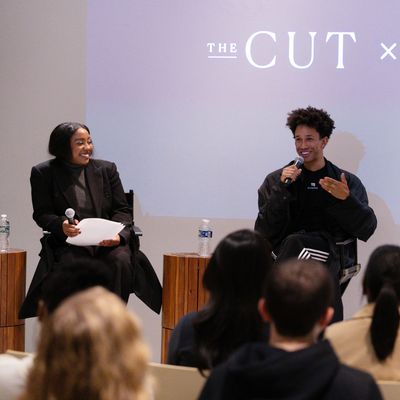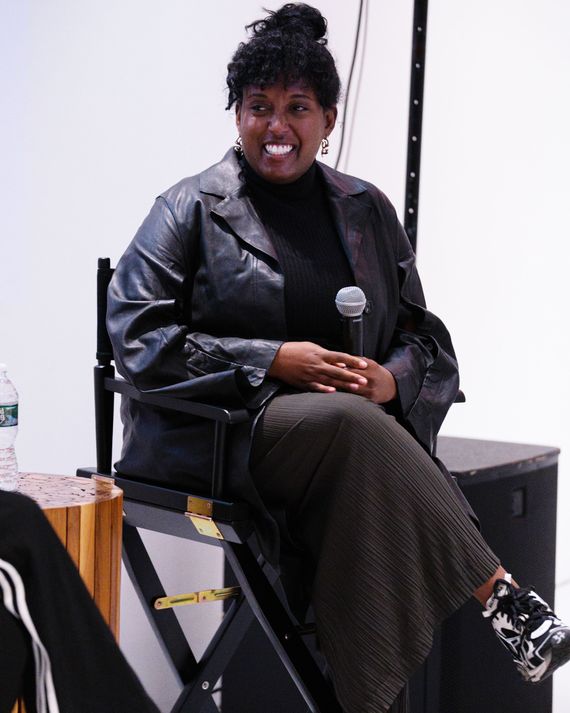
Update March 1, 2023: On The Cut this week, we’re sharing with you a panel editor-in-chief Lindsay Peoples moderated at the New Museum back in December with artists Miles Greenberg and Salome Asega. You can listen to the episode below and read our original write-up of the event as well.
The Cut
Subscribe on:
This week, the Cut’s editor-in-chief Lindsay Peoples gathered with performance artist and sculptor Miles Greenberg and Salome Asega of the New Museum for a panel conversation titled “Imagining Radical Futures Through Art and Technology.”
Greenberg — whose exhibition “The Shadow of Spring” is currently on view at the New Museum — centers the physical body in his work, often using sculpture to complete his immersive experiences. “The Shadow of Spring,” which was created in collaboration with experimental musician Vivian Cacurri, interrogates sound and vibration and their abilities to create collective transformative experiences. The exhibit features sculptures, embroidery pieces, and sound works all exploring how the body interacts with and is affected by sound waves.
Asega, who works as the director of New Inc, a New Museum–led incubator for art, technology, and design, is also an artist and researcher whose work bridges the gap between technology and traditional art practices. Her work, past and present, is meant to foster community through tech. Take, for example, her 2014 project The Crown Heights Mic. A sort of radio broadcast network constructed by Crown Heights residents and other neighborhood stakeholders that created “sound funnels” around public spaces like schools, libraries, and places of worship to document local voices and storytelling.
Below, excerpts from their conversation.
Miles Greenberg on performance
“It’s always just been kind of intuitive. I didn’t go to school — I think that helped. I think performance is something that I was really attracted to, and lucky to be introduced to, at a very young age as a medium through which I could articulate an idea without any material necessities, and it’s something that’s both accessible to a public and accessible to one as a creator.”
… and collaborating
“Me and my counterpart Vivian Cacurri actually didn’t meet IRL until a week before we opened. We were both approached with this idea simultaneously of vibrations and started talking very broadly of the commonalities of collective laboratory experiences in churches and sex clubs. We found a mutual planet where we wanted to articulate a space that felt both intimate and chapel-like. The back of the space is so unique; it’s very narrow, so you have very little space to work with. But that gives you a very nestled feeling where you are literally visible to the street. The challenge we gave ourselves was to find a way to trigger bodily sensation to make people feel their bodies, their fluids, and their viscera while being so completely vulnerable, and that’s hard to do.”
Salome Asega on storytelling
“There are many engineers in my family, so growing up, while they were learning how to code or while they were practicing software engineering, they would send me and my brother floppy-disk game prototypes and we would have to play them and find the bugs and send them back, and I always thought, You know, this is not just coding, it’s storytelling. So for me, I was really influenced by the ways that technology can help you storytell, but in terms of the intersection of art and technology, I like to tell people that I’m ‘tech agnostic.’ For me, the story and the people in the communities I work within are driving the work that I make and the technology is supplemental. That’s why we look to technology second to figure out what is the best tool to tell the story.”
… and the dangers of tech and the rise of AI
“I think the Lensa stuff is really funny because people are very quickly submitting their selfies to a platform without knowing kind of the consequences or what will happen to those images later — and what we’re training and how that company will benefit from all this learning. For me, it comes back to building ‘consentful technology.’ I feel like people know that something is wrong — to the point that my aunt will be like, ‘It’s the algorithms, right?’ Like, when your own aunt is saying something about the algorithms, we know that there’s kind of a mainstream, top-level knowledge of something being wrong. But how do we dig into a second layer of media literacy and tech literacy so people really understand the details of how our data moves?”
Greenberg on audiences experiencing his art
“I make art in a way that I feel most comfortable looking at it. I don’t love interactive stuff and I find it weird when performers talk to me, so I don’t do that. I’m always working from a place of ‘Where do I feel most available to receiving information?’ Sometimes that’s not through new technologies. I think of the Louvre and walking around with my headphones in as the awkward art kid that didn’t go to art school staring up at these things that feel ostensibly eternal. That’s the kind of art I want to make. That fact that I use performance kind of feels incidental to the fact that I still achieve that in a way through my body and eventually through sculptures, through video, etcetera. I always look at it through the lens of “What’s the most reasonable expectation that I can have of my audience?” Because it’s how I would care for myself in a space of cultural consumption.”
Asega on directing the New Museum’s cultural incubator
“I have a really long history with the program. I was in the third cohort and came back as a mentor. Now to come back as director, I feel like I have a full 360 of the program, and it really feels horizontal for artist practitioners in terms of vision and dreams. Coming out of a pandemic, we’re having really critical conversations about artists and artists as workers in our relationship to labor and creative economies and economies at large. So that’s really interesting to me as a cultural incubator whose mandate, whose North Star, is to think about ways cultural practitioners can build sustainable careers. We’re having really rigorous conversations about collectivity and cooperativism and it gives me hope.”






